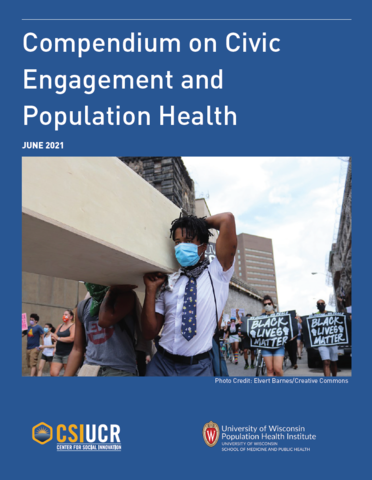Center for Social Innovation

Compendium on Civic Engagement and Population Health
The Civic Engagement and Population Health Compendium is a concise collection of research and materials on civic engagement and population health. It includes key concepts, indicators, and datasets related to civic engagement, broadly and comprehensively defined, measured at the individual and group level, and across varied geographic scales.
It is by now widely recognized that population health is shaped not only by clinical care, but also by community conditions such as affordable housing, quality education, living wage jobs, and even more broadly by social and economic factors such as poverty and discrimination, and policy-related factors like immigrant integration and exclusion. This shift in our understanding has been based on a deep body of empirical research and built on theoretical and conceptual frameworks involving social determinants and policy contexts affecting health outcomes.
Over the last decade, there has been a growing recognition that voting and other forms of civic engagement are also connected to population health and health disparities. And yet, the theoretical and empirical connections between civic engagement, community and policy conditions, and population health outcomes have not been well established. This compendium is part of a larger project, funded by the Robert Wood Johnson Foundation, that aims to improve research and understanding of the range of civic engagement measures and their connections to community conditions and population health and equity.
The focus of this compendium is to articulate the broad array of concepts and measures relevant to civic engagement that extend far beyond voter registration and voter turnout. These have been measures that are most broadly available, and that most often have been used to illustrate connections to health. When it comes to policy influence, activities like contacting officials, making campaign contributions, and attending public hearings can be much more consequential than voting. Ultimately, policies are shaped not only by individuals and groups that vote, but also by those that continue to engage between elections and campaigns. Thus, groups and/or communities that experience fewer barriers to involvement in various forms of civic engagement are more likely to have their needs addressed than those groups that have limited opportunities to participate, or that otherwise face barriers to civic engagement.
While there is more to be studied on the causal pathways and institutional conditions that connect civic engagement to health and equity, this compendium offers a window into one side of this complex relationship with a focus on the varieties of civic engagement. Instead of limiting attention to voter registration and voter turnout, we expand the scope to consider other forms of electoral participation such as making campaign contributions; non-electoral forms of political participation such as attending public meetings and contacting public officials; and forms of civic participation including boycotting products, volunteering for a charitable organization, and working with others to solve community problems. We also consider the media contexts and institutional rules—ranging from absentee ballot provisions to voter registration rules and voter identification laws—that shape participation and have the potential to exacerbate civic inequity. Finally, the compendium also provides a parsimonious set of population health concepts and metrics that can be used in subsequent analyses that relate particular types of civic engagement (and inequities in civic engagement) to inequities in various health outcomes.
This compendium was written as part of Civic Engagement and Population Health Initiative, a joint project of the University of California, Riverside and the University of Wisconsin Population Health Institute, and supported by the Robert Wood Johnson Foundation.
